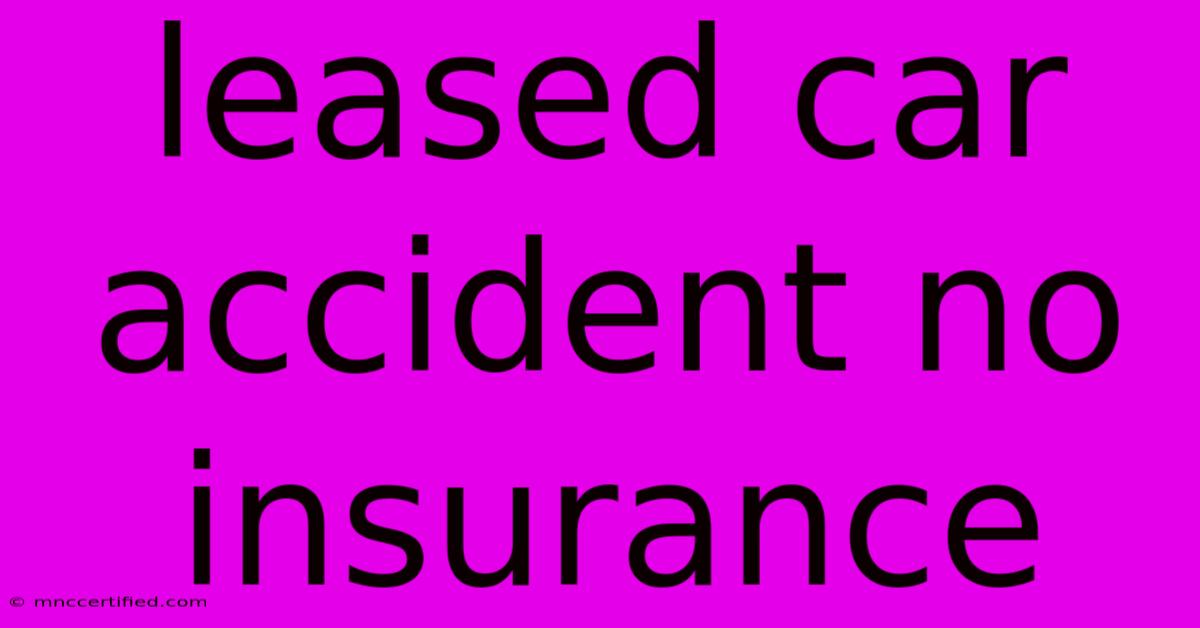Leased Car Accident No Insurance

Table of Contents
Leased Car Accident: Navigating the Insurance Maze When You're Underinsured or Uninsured
Being involved in a car accident is stressful enough, but the situation becomes significantly more complicated when you're leasing a car and lack sufficient insurance coverage. This guide breaks down the potential scenarios and steps you need to take when you're in a leased car accident with no insurance or inadequate coverage.
Understanding Your Lease Agreement
Before we delve into the aftermath of an accident, it's crucial to understand the specifics of your lease agreement. Your contract likely outlines your responsibilities regarding insurance coverage. Failing to meet these requirements can result in significant financial penalties. Common stipulations include:
- Minimum insurance requirements: Your lease likely specifies minimum liability, collision, and comprehensive coverage limits. Falling below these limits puts you at risk.
- Gap insurance: This covers the difference between the actual cash value of your vehicle and the amount you still owe on the lease if your car is totaled. It's highly recommended for leased vehicles.
- Lease termination clauses: Severe breaches of the insurance requirements could lead to early lease termination and significant financial repercussions.
Review your lease agreement thoroughly. Understanding your contractual obligations is the first step in mitigating potential problems.
What to Do Immediately After an Accident
Regardless of the insurance situation, these steps are crucial after any accident:
- Ensure Safety: Prioritize the safety of yourself and others involved. Call emergency services if needed.
- Gather Information: Collect information from all parties involved, including names, contact details, driver's license numbers, insurance information (even if limited), and license plate numbers. Take photos of the damage to all vehicles, the accident scene, and any visible injuries.
- Contact the Police: Reporting the accident to the police is vital, especially if there are injuries or significant damage. The police report provides crucial documentation.
- Contact Your Leasing Company: Notify your leasing company immediately, even before contacting your insurance provider. Explain the situation honestly and provide details of the accident.
Leased Car Accident with Inadequate Insurance
If your insurance coverage is insufficient to cover the damages, you face a serious situation. Here’s what you need to consider:
- Liability Claims: If you're at fault, you'll be responsible for the damages to the other party's vehicle and any injuries sustained. Your limited coverage might not be enough, leaving you with significant out-of-pocket expenses.
- Collision Coverage: Even if you have collision coverage, it might not fully cover the repair costs, especially if your vehicle is extensively damaged. You could be left with a substantial balance to pay.
- Negotiating with the Other Party's Insurance: If you're at fault, work with the other driver's insurance company. Providing them with all necessary documentation is key.
- Financial Responsibility: Be prepared for potential significant financial responsibility, even if you weren't at fault. This is where gap insurance becomes crucial.
Leased Car Accident with No Insurance
Driving a leased car without insurance is a serious offense, leading to several consequences:
- Legal Penalties: You'll likely face fines, license suspension, and potential criminal charges.
- Leasing Company Penalties: Your leasing company will likely demand immediate payment for damages and may terminate your lease agreement.
- Difficulty in Claiming: You’ll face significant challenges in getting any compensation for damages to your vehicle, and you will be solely responsible for the other party’s losses.
- Financial Ruin: The financial consequences of driving without insurance after an accident can be devastating.
Preventing Future Problems
To avoid this stressful situation, consider these proactive steps:
- Adequate Insurance Coverage: Ensure you have sufficient liability, collision, and comprehensive insurance coverage that meets or exceeds your lease agreement's requirements.
- Gap Insurance: Protect yourself from financial losses by securing gap insurance.
- Regular Policy Review: Review your insurance policy regularly to ensure it aligns with your needs and complies with your lease agreement.
Disclaimer: This article provides general information and should not be considered legal or financial advice. Consult with a legal professional and your insurance provider for advice specific to your situation.

Thank you for visiting our website wich cover about Leased Car Accident No Insurance. We hope the information provided has been useful to you. Feel free to contact us if you have any questions or need further assistance. See you next time and dont miss to bookmark.
Featured Posts
-
Chris Sale Wins Nl Cy Young Award
Nov 22, 2024
-
Supplement Car Insurance Meaning
Nov 22, 2024
-
2007 Toyota Camry Insurance Cost
Nov 22, 2024
-
Indian Billionaire Adani Faces Us Charges
Nov 22, 2024
-
Leased Car Accident No Insurance
Nov 22, 2024